#Persicaria pensylvanica
Text
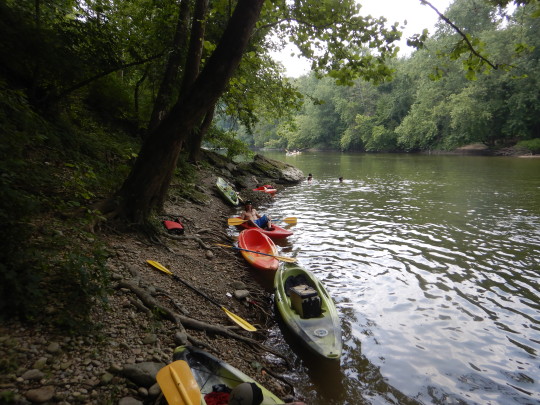

Along the Little Miami Inbetween hamilton and clermont co is a section that maintains conglomerate mudstone layer and a lot of mud banks close enough to mudflats that you still get some classic mudflat species and riparian gravel bar species.

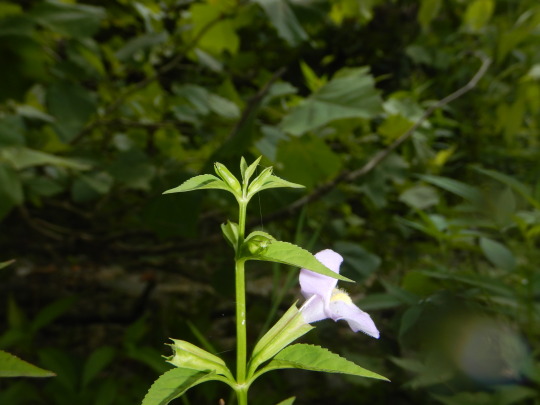
The first is the winged monkey flower(Mimulus alatus) , known for winged squared of stems, though since Ohio gets both, if you need to collect seeds for bioswale forbes and want to differentiate them when the stem is brown, the peduncle, aka main stem that holds/bares a flower or a fruit attached to the stem, is almost sessile or near sessile, aka still there but close to not existing where as Allegheny is elongate.



a gravel bar species requiring full sun is Hibiscus moscheutos or the swamp rose mallow, it's about as common as our other native Hibiscus laevis or the halberd leafed mallow; this species pictured has more common smaller colonies with pink flowers on average with what most assume as a non deeply lobed leaf differing from a halberd lobed white flower with taller plants on average and larger colonies.

Wouldn't be a good gravel bar without falls redest sedum, Ditch stone crop! or is it a sedum really???, while we used to assume based on morphological features it is no longer placed in the genera Sedum and is Penthorum sedoides a non succulent water loving species that actually has found it's self as a member of the saxifrage order. It is one of two species that I know of in the genera, and is associated with it's own family as of now. It is also the only member of the genus within the United States. Side note: As a member or the saxifrage order I don't even know if this species utilizes CAM to be honest and it wouldnt benefit it if you think about it.



Lindernia dubia
false pimpernel
Associated with the mudflats, it's funny because people call this and many others the mudflat ephemerals because they are brief and seasonal inbetween flood stages. These always look like a monkey flower at first glance before you know the species.
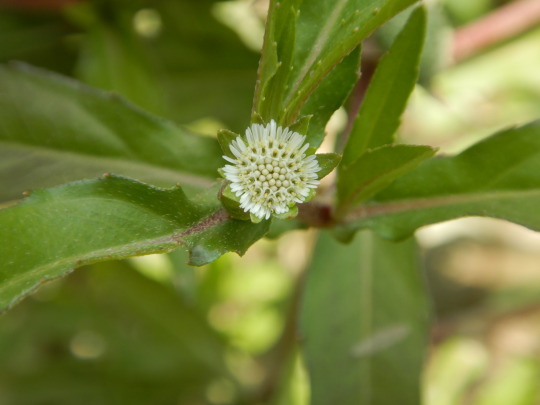
Eclipta prostrata
Mudflat false daisy, a riparian and swale species but also very common on mudflats.
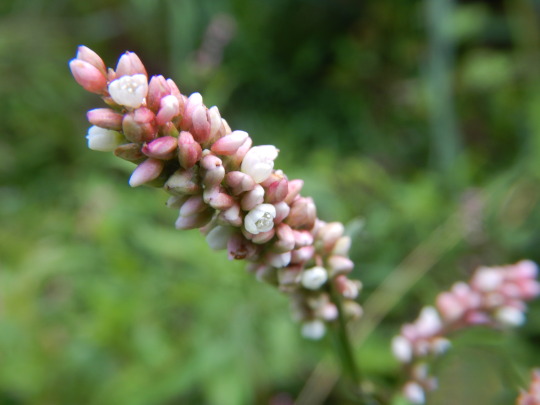
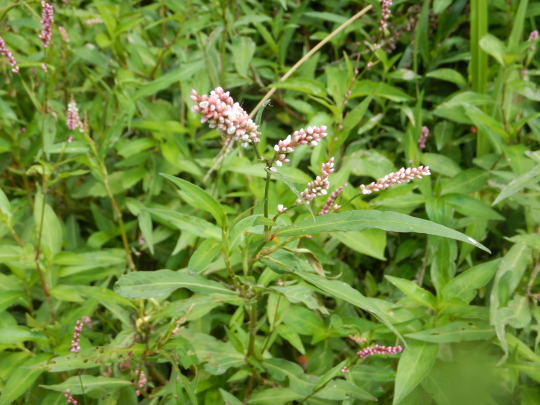


Persicaria pensylvanica or pensylvania smart weed, is a robust flowering species that forms semi erect inflorescence that are peppered pink and white. and easy to differentiate when you look at a non frimbrate connected ocrea that sheathes both stem and petiole. you can see invasive Persicaria longiseta or oriental bristled ladies thumb with frimbrate ocrea in background :( spicy flowers on our natives less spicy on the non natives.
#mimulus#mimulus alatus#ringens#botany#ohio#mudflats#riparian#hibiscus moscheutos#hibiscus laevis#hibiscus#lindernia dubia#lindernia#mudflat#ephemeral#penthorum#penthorum sedoides#eclipta prostrata#Persicaria pensylvanica
22 notes
·
View notes
Text
Wildflower Walk ?
Hello everyone! I hope this post finds you all well. I apologize for not posting for a while. It has been a weird summer for sure with the heat and drought. I was busy with the garden picking sweet corn and green beans right up until August 17. Somehow I managed to get 455 ears of sweet corn in the freezer, and thanks to the ‘Provider’ green beans, 34 quarts of green beans. Of course, not all the…
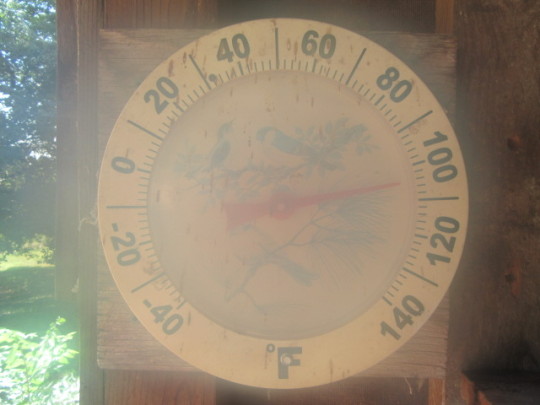
View On WordPress
#Ambrosia bidentata (Lanceleaf Ragweed)#Asclepias hirtella (Prairie/Tall Green Milkweed)#Asclepias syriaca (Common Milkweed)#Bidens aristosa (Tickseed Sunflower or Bearded Beggarticks)#Datura stramonium (Jimson Weed)#Elephantopus carolinianus (Leafy Elephant&039;s Foot)#Erechtites hieraciifolius (Fireweed/Pilewort)#Erigeron annuus (Annual or Daisy Fleabane)#Etc.)#Eupatorium serotinum (Late Boneset)#Impatiens capensis (Jewelweed)#Lespedeza cuneata (Chinese Bushclover)#Persicaria hydropiper (Water Pepper)#Persicaria pensylvanica (Pinkweed)#Phytolacca americana (American Pokeweed)#roton capitatus (Hogwort/Woolly Croton/Goatweed)#Rudbeckia hirta (Black-Eyed Susan)#Sida spinosa (Prickly Fanpetals)#Solanum sarrachoides (Hairy Nightshade)#Solidago sp. (Goldenrod)#Symphyotrichum lateriflorum (Calico Aster)#Tridens flavus (Purpletop#Tripsacum dactyloides (Eastern Gamagrass)#Verbesina virginica (White Crownbeard/Frostweed)#Vernonia missurica (Missouri Ironweed)
0 notes
Text
Rook Hunt — language of flowers
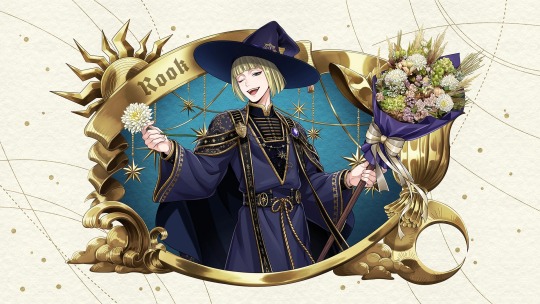
white dahlia — symbolizes innocence, purity and new birth (if the person gives dahlias, there is a slightly different message, namely: I admire you, you are beautiful (not just outwardly, the message is more based on inner beauty*), I am happy with you), and white dahlia means greatness
white chrysanthemum (rook holds flower) — sincere and pure love, honesty, truth. chrysanthemum also signify death and rebirth. this could be a reference to the fact that rook used to study at savanaclaw (i.e. died) and went to pomfiore (i.e. reborn)
limonium — eternity and "unchanging heart" (roughly speaking, it's devotion, but the message here goes much deeper)
miscanthus chinensis — vitality, power
pink carnation - gratitude, elegance, warm heart, also pink carnations indicate good manners (especially with regard to courtship)
persicaria pensylvanica (buckwheat family) — symbolise a lover
white roses — loyalty, purity, love, literally say 'you are beautiful and perfect'
p.s. RookVil moment from Ignihide's story is a perfect fit for this value (you can see more HERE)
171 notes
·
View notes
Text
Native Plants I’ve Actually Seen Growing Wild in Southern Ontario
Acer saccharinum (silver maple) --along the sides of highways
Acer saccharum (sugar maple) --GTA ravines
Achillea millefolia (yarrow) --GTA ravines
Allium schoenoprasum (wild chives) --GTA ravines, Ridgetown
Allium tricoccum (ramps) --Niagara region escarpments
Amaranthus retroflexus (redroot amaranth) --fallow areas in the GTA
Ambrosia artemisiifolia (ragweed) --fallow areas in the GTA
Ambrosia trifida (giant ragweed) --parks in the GTA
Amelanchier spp. (saskatoon/serviceberry) --GTA ravines
Arisaema triphyllum (Jack-in-the-pulpit) --GTA ravines
Aronia melanocarpa (black chokeberry) --ravines and parks in the GTA
Asarum canadense (Canada ginger) --GTA ravines
Asclepias syriaca (common milkweed) --fallow areas, ravines, and parks throughout southern Ontario from Windsor to GTA
Asplenium trichomanes (maidenhair spleenwort) --Niagara region escarpments
Betula spp. (birch) --ravines and parks throughout southern Ontario from Windsor to GTA
Bidens spp. (beggar ticks) --GTA ravines
Caulophyllum thalictroides (blue cohosh) --GTA parks
Ceratophyllum demersum (hornwort) --GTA ravines (native in freshwater across the globe anyway)
Circaea lutetiana (enchanter’s nightshade) --fallow areas in the GTA
Commelina spp. (dayflower) --fallow areas in Windsor
Cornus alternifolia (Pagoda dogwood) --GTA wooded areas
Cornus sericea (red osier dogwood) --GTA ravines and in Windsor riverside parks
Crataegus spp. (hawthorn) --GTA ravines and parks
Echinocystis lobata (wild prickly cucumber) --GTA ravines
Elaeagnus commutata (silverberry) --GTA parks and fallow areas
Epilobium ciliatum (fringed willowherb) --fallow areas in the GTA
Equisetum spp. (horsetail/scouring rush) --GTA ravines and fallow areas
Erigeron spp. (fleabane) --GTA parks and fallow areas, Ridgetown
Erythronium americanum (trout lily) --GTA ravines and parks
Eutrochium maculatum (Joe-Pye weed) --GTA parks
Fragaria virginiana (wild strawberry) --fallow areas in the GTA
Geranium maculatum (wild geranium) --Windsor green spaces
Geranium robertianum (herb robert) --Windsor green spaces
Geum aleppicum (yellow avens) --GTA fallow areas
Geum canadense (white avens) --GTA fallow areas
Geum macrophyllum (large-leaved avens) --GTA fallow areas
Gymnocladus dioicus (Kentucky coffee tree) --GTA ravines
Helianthus spp. (sunflower) --GTA fallow areas and parks
Heracleum maximum (cow parsnip) --GTA ravines
Hordeum jubatum (foxtail barley) --GTA fallow areas
Humulus lupulus (hops) --GTA ravines
Hydrophyllum virginianum (Virginia waterleaf) --GTA ravines
Impatiens capensis (jewelweed) --GTA ravines and in Windsor riverside parks
Juglans nigra (black walnut) --GTA ravines
Lactuca canadensis (Canadian lettuce) --GTA fallow areas
Lilium michiganense (Michigan lily) --GTA ravines
Lupinus perennis (sundial lupine) --GTA parks
Maianthemum canadense (Canada mayflower) --GTA ravines
Maianthemum racemosum (starry false solomon’s seal) --GTA ravines and parks
Maianthemum stellatum (starry false solomon’s seal) --GTA ravines
Matteuccia struthiopteris (ostrich fern) --GTA ravines
Monarda fistulosa (wild bergamot) --GTA ravines and parks
Morus rubra (red mulberry) --fallow areas in Windsor, GTA parks
Myosotis laxa (smallflower forget-me-not) --GTA fallow areas
Oenothera biennis (evening primrose) --GTA fallow areas
Onoclea sensibilis (sensitive fern) --GTA ravines
Oxalis stricta (yellow wood sorrel) --fallow areas and ravines throughout southern Ontario from Windsor to GTA
Parietaria pensylvanica (Pennsylvania pellitory) --GTA fallow areas
Parthenocissus quinquefolia (Virginia creeper) --Windsor fallow areas and GTA ravines and parks
Persicaria lapathifolia (curlytop smartweed) --GTA fallow areas
Podophyllum peltatum (mayapple) --GTA ravines and parks
Portulaca oleracea (purslane) --fallow areas throughout southern Ontario from Windsor to GTA (native globally anyway)
Potentilla norvejica monspeliensis (ternate-leaved cinquefoil) --GTA fallow areas
Prunella vulgaris (selfheal) --fallow areas and ravines throughout southern Ontario from Windsor to GTA
Prunus virginiana (chokecherry) --Windsor fallow areas, GTA ravines and parks, Niagara region escarpments
Pteridium aquilinum latiusculum (western bracken fern) --GTA parks
Quercus spp. (oak) --wooded areas throughout southern Ontario from Windsor to GTA
Rhus typhina (staghorn sumac) --parks and fallow areas throughout southern Ontario from Windsor to Collingwood
Ribes spp. (currants) --GTA ravines and parks
Ribes spp. (gooseberries) --GTA ravines
Robinia pseudoacacia (black locust) --GTA ravines and parks
Rosa spp. (roses) --GTA ravines, parks, and fallow areas
Rubus occidentalis (black raspberry) --ravines, parks, and fallow areas in Hamilton and GTA
Rubus odoratus (purple-flowered raspberry) --GTA ravines and parks
Rubus strigosus (American red raspberry) --GTA parks
Rudbeckia hirta (black-eyed susan) --GTA parks
Salix spp. (willow) --GTA ravines
Sambucus canadensis (common elderberry) --Windsor riverside parks, GTA ravines
Sambucus racemosa (red elderberry) --GTA ravines and parks
Smilax spp. (greenbrier) --GTA parks
Solidago canadensis (Canada goldenrod) --parks and fallow areas throughout southern Ontario from Windsor to GTA
Sorbus spp. (mountain ash) --GTA ravines and parks
Streptopus spp. (twistedstalk) --GTA parks
Symphoricarpos spp. (snowberry) --GTA parks
Symphyotrichum ericoides (heath aster) --fallow areas throughout southern Ontario from Windsor to GTA
Symphyotrichum novae-angliae (New England aster) --fallow areas throughout southern Ontario from Windsor to GTA
Symplocarpus foetidus (skunk cabbage) --GTA parks
Tilia spp. (linden) --GTA ravines
Trillium grandiflorum (white trillium) --parks throughout southern Ontario from Windsor to GTA
Tsuga canadensis (eastern hemlock) --GTA parks
Typha latifolia (broad-leaved cattail) --marshes in Essex county and GTA
Urtica gracilis (slender nettle) --GTA ravines
Uvularia spp. (bellwort) --streams in Windsor green spaces
Verbena hastata (blue vervain) --GTA ravines
Viburnum lentago (nannyberry) --GTA parks and Ridgetown ravine
Viburnum trilobum (highbush cranberry) --Ridgetown
Viola sororia (wood violet) --fallow areas and wooded areas throughout southern Ontario from Windsor to GTA
Vitis riparia (riverbank grape) --GTA fallow areas, ravines, and parks
Waldsteinia fragarioides (barren strawberry) --GTA ravines and parks
Xanthium strumarium canadense (Canada cocklebur) --GTA parks and fallow areas
I’ve likely seen many others and just couldn’t identify them, but there are a lot I’ve never seen growing wild. What I’m hoping is that some of the native species I have in my garden will make their way to the nearby ravine. If I get around to it, though, I might just take a walk with some Asclepias incarnata (swamp milkweed) seeds in the fall. They certainly seem to successfully germinate in my garden whether I want them to or not (don’t have space for them to go crazy). Can’t see why they wouldn’t in a natural swamp area.
#text post#long text post#native plants of Ontario#native plants of North America#wild native plants
10 notes
·
View notes
Text
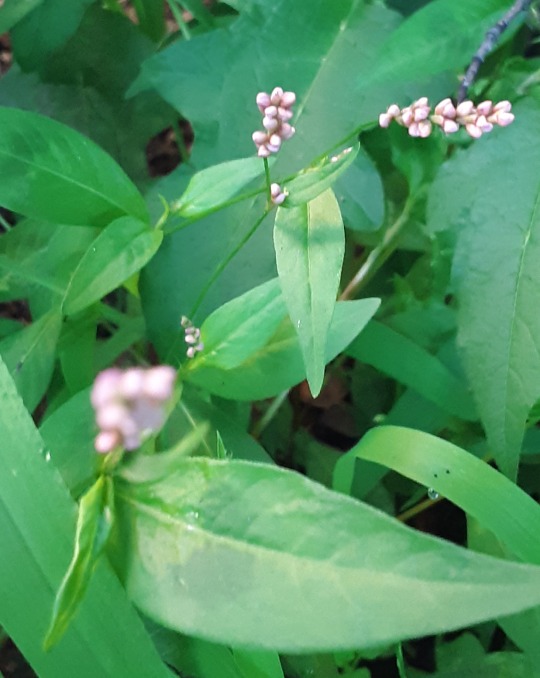
Pinkweed ?
Persicaria pensylvanica
Aka. Pennsylvania smartweed
This member of the buckwheat family is native to North America. It's been introduced to Europe and South America. They like moist environments and can be found near ditches, waste ground and bodies of water.
The Meskwaki used pinkweed tea to treat diarrhea, a leaf poultice was used for hemorrhoids. Leaf tea was used to stop bleeding from the mouth and post partum healing. Tea from the flower heads were used to treat epilepsy. Iroquois used it for horse cholic.
Sources
Wikipedia Persicaria pensylvanica
Peterson Field Guide to Medicinal Plants and Herbs of Eastern and Central North America 3rd edition by Steven Foster and James A Duke
1 note
·
View note
Photo

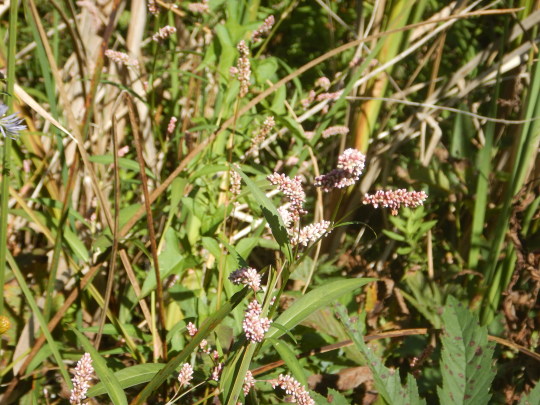
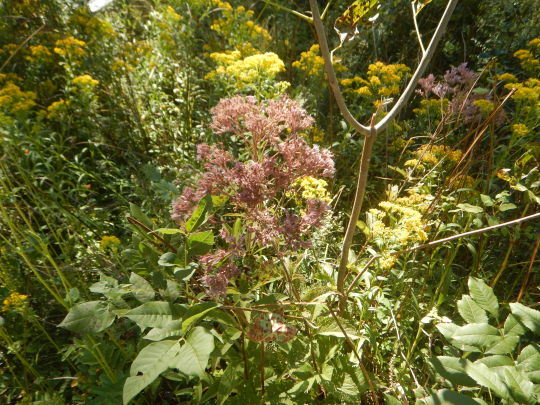

More photographs from Woodman fen,
Persicaria pensylvanica,
Persicaria spp. can be hard to tackle. There are plenty of morphological traits to look at when trying to differentiate species. For this one the main things to look at are: how long is the seta? are there black spots on the center of each leaf, how glandular is the top of the stem, is the inflorescence elongate, is the inflorescence nodding or imbricate and erect.
For this species we see the seta is not elongate nor does the seta terminate with tenuous fibers taking out from Persicaria longiseta.
It is not glandular up top, taking it away from federally threatened Persicaria careyi. Not to mention that it is also not large enough nor nodding. The nodding aspect also removes the possibility of Persicaria lapathifolia
The lack of a black dot on the leaves removes the possibility of Persicaria maculosa, a non native annual.
and the species is clearly not forming a non-imbricate (not densely arranged) elongate inflorescence Persicaria hydropiper
leaving only Persicaria pensylvanica as our culprit.
The two bottom photos are that of a section of a forbe swale containing that of Ohio Goldenrod and Spotted Joe Pye and a photo of the Symphyotrichum firmum, or glossy leaved swamp aster, formerly part of the swamp aster complex. Known for forming massive colonies, having smaller, but more flowers on average with paler white colored ligules(ray or tongue pseudo-petaloid flowers in the composite/aster family) compared to the blue of swamp aster as well as glossier adaxial(top) leaf surfaces.
#persicaria#wildflowers#persicaria pensylvanica#botany#ohio#fens#woodman fen#symphyotrichum firmum#symphyotrichum#kawaii#meadow#meadowcore
18 notes
·
View notes
Text
Problem Areas and Wild Weeds, ETC. Part 3...
Problem Areas and Wild Weeds, ETC. Part 3…
Torilis japonica (Japanese Hedge Parsley)…
Hello everyone! I hope this post finds you well. October is here once again and some of the wildflowers aren’t looking their best. There are a lot of insects and butterflies feeding right now. I have taken a lot of photos the last few days and I am getting behind. 🙂 I now have 655 observations posted on iNaturalist covering 343 species.
This saga of the…
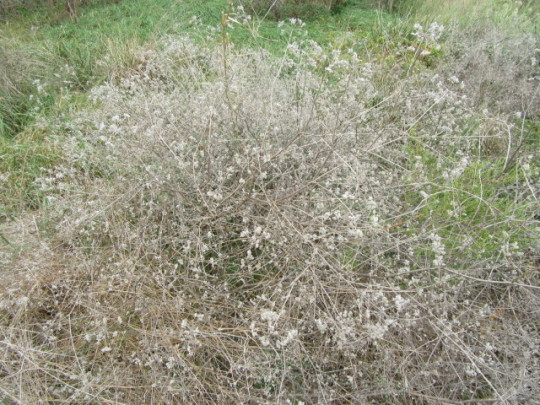
View On WordPress
#Danaus plexippus (Monarch Butterfly)#Eleusine indica (Goosegrass)#Eupatorium altissimum (Tall Thoroughwort)#Eupatorium serotinum (Late Boneset)#Persicaria hydropiper (Water Pepper)#Persicaria pensylvanica (Pinkweed)#Rhus glabra (Smooth Sumac)#Symphyotrichum novae-angliae (New England Aster)#Torilis japonica (Upright/Japanese Hedge Parsley)#Vernonia missurica (Missouri Ironweed)#Xanthium strumarium (Rough Cocklebur)
0 notes
Text
Perplexing Persicaria
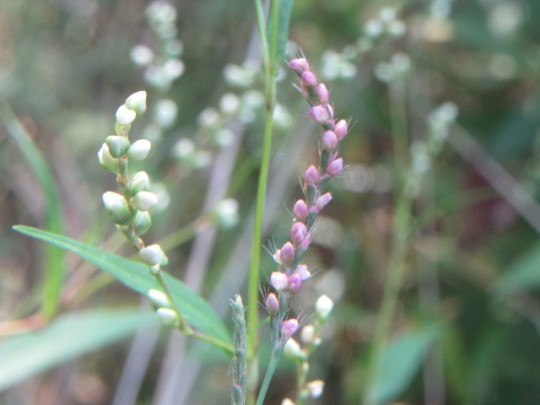
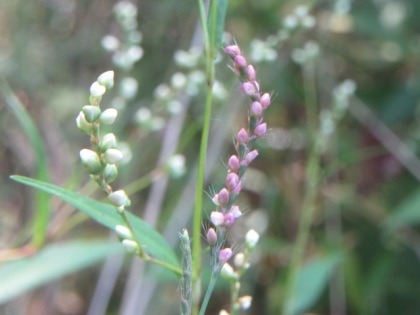
Persicaria punctata (Dotted Smartweed) on the left and Persicaria longiseta (Oriental Lady’s Thumb) on the right. This photo was taken near the pond at the back of the farm on 9-7-19. Persicaria punctata has “dots” on the flowers and Persicaria longiseta has cilia (hairs) on their flowers.
Hello everyone! I hope this post finds you all well. I think it has been three months since I decided to…
View On WordPress
#Persicaria hydropiper (Water Pepper)#Persicaria longiseta (Oriental Lady&039;s Thumb)#Persicaria maculosa (Lady&039;s Thumb)#Persicaria pensylvanica (Pinkweed)#Persicaria punctata (Dotted Smartweed)#Persicaria sagittata (Heartleaf Tearthumb)#Persicaria virginiana (Virginia Knotweed)
0 notes
Text
Introduction To The Next Post (Perplexing Persicaria)...
Introduction To The Next Post (Perplexing Persicaria)…
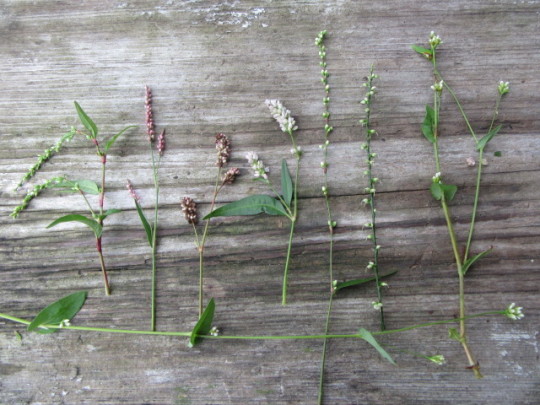
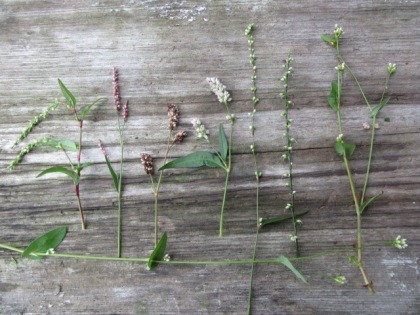
Persicaria species from left to right: Persicaria hydropiper (Water Pepper), Persicaria longiseta (Oriental Lady’s Thumb), Persicaria maculosa (Lady’s Thumb), Persicaria pensylvanica (Pinkweed), Persicaria punctata (Dotted Smartweed), Persicaria virginiana (Jumpseed), and Persicaria sagittata (Heartleaf Tearthumb) (also along the bottom. Photo taken on 9-22-19, #635-3.
Hello everyone! I hope this…
View On WordPress
0 notes